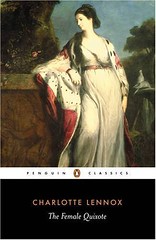
The Female Quixote / Charlotte Lennox
London : Penguin Books, 2006
Originally published: 1752
liii, 465 p.
Beautiful and independent, Arabella has been brought up in rural seclusion by her widowed father. Devoted to reading French romances, the sheltered young woman imagines all sorts of misadventures that can befall a heroine such as herself. As she makes forays into fashionable society in Bath and London, many scrapes and mortifications ensue -- all men seem like predators wishing to ravish her, she mistakes a cross-dressing prostitute for a distressed gentlewoman, and she risks her life by throwing herself into the Thames to avoid a potential seducer. Can Arabella be cured of her romantic delusions An immediate success when it first appeared in 1752, The Female Quixote is a wonderfully high-spirited parody in the style of Cervantes, and a telling and comic depiction of eighteenth-century English society.
Wow, I read this approximately infinity days ago and totally forgot to say anything about it, which is surprising because it took me over a month to finish because it gets a bit long and slightly repetitive. The plot is outlined above, and it progresses exactly how you'd expect an 18th-century romance about a girl like this would progress.
As I say, it's long and predictable. But honestly, it's excusable because a) there are parts that are genuinely funny, and b) the protagonist Arabella is just so darn likeable! Especially if you've read any French romances or even something like the Heptameron, you can understand how she can take the outdated women's mindset so seriously, and I found myself sympathizing with her despite her tiresome repetition of her strange sensibilities.
The book has problems, though. If you don't know the vast body of literature from which Arabella samples, you may find yourself skimming entire sections of synopsis. It's not so bad, though. Also, the ending feels very rushed. She has one conversation with one new character and VOILA LA SALADE, she is cured of her ridiculousness. They say it's because Lennox had enough material for X number of volumes, but not enough to have X+1 volumes, so she wrapped things up quickly. It's easy to overlook, though. Since the plot itself is so implausible, the ending, in my opinion, doesn't need to be too complex. The ending isn't the point of a book like this anyway, it's more to showcase silly situations that comment on the society at the time.
All in all: cute, but I'd suggest not making it your first foray into the world of 18th-century literature.



No comments:
Post a Comment